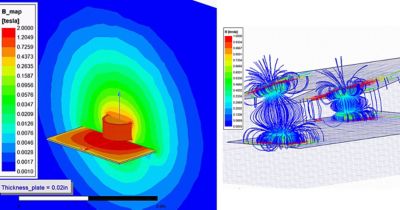Multiphysics simulations are becoming increasingly common thanks to more accurate and easier-to-use simulation tools, an abundance of cheap compute in the cloud, and growing expertise for how to build accurate and reliable multiphysics simulations.
A simulation, however, is only as accurate as its inputs and has many moving parts that must stand up to scrutiny to enable engineers to gain the insights needed to reliably optimize their products. Engineers must be able to find, reuse, and trust consistent high-quality materials information to ensure accurate, reliable simulation. Materials data and information are often difficult to find and expensive to gather. An immense amount of effort is required to manage and store information, data, properties, and characteristics for the multitude of materials that go into products.
Typically, materials information is curated and managed by materials engineers and then shared across organizations for use throughout different silos of expertise. That frequently is done via spreadsheets, data sheets, and text files used by engineering departments for simulation and analysis. This may create several issues, such as different materials data being used by design and simulation teams, inaccurate materials data that doesn’t represent reality, and valuable time wasted seeking, inputting, and formatting data. All this can lead to repetitious simulations, inconsistent data used in different departments, poorer simulation quality, and lower engineering productivity.
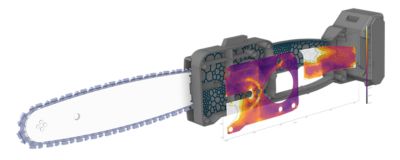
You can build more accurate simulations and reduce the number of errors and prototypes by connecting to an authoritative source of truth for materials.
Ensure Consistency in Materials Information
Multiphysics simulations require high-quality materials data and properties that sometimes can be hard to obtain. But even if a company has this data, it must be available to the simulation engineers, and they need to trust that they are using the latest, approved version of their selected material. Enter the Ansys Granta MI materials intelligence platform, a comprehensive solution for engineering materials data management. The Granta MI platform drives innovation and efficiency while reducing costs and risk. It is the foundation for digitizing materials data, making it a “gold standard” source of data across a business. By enabling all engineering teams to use the same, consistent materials data, time to market can be accelerated for design while also improving engineer productivity.
Companies can ensure consistency and control by integrating a centrally managed, traceable, approved source of materials data into the entire product design and development process. In other words, this means using a single source of truth for materials information. This source of truth can help reduce the engineering workload and enable engineers to focus on building correct simulations rather than spending inordinate amounts of time finding data or getting into situations in which prototypes do not behave as predicted by models.
Imagine having to run an electrothermal simulation for which you know well the electric properties of the material that you are using but you are unsure about its thermal properties. Armed with the name and grade of the material, you scour engineering handbooks, supplier data sheets, and websites to identify the missing information. In the end, you have spent an enormous amount of time and effort and you have managed to get only incomplete information. So what do you do?
You most likely repeat the simulations until you get something that makes sense or looks reasonable, possibly even building prototypes to test your assumptions. Still, you end up unsure about the trustworthiness of your simulations.
This is a very common reality for thousands of engineers. But there is a better way. You can use curated, accurate data from a materials database that contains information for all physics on the same material and grade. The Granta MI platform’s materials libraries cover most standard engineering materials and are based on proven sources, including Ansys’ comprehensive MaterialUniverse database and the JAHM simulation dataset from JAHM Software Inc. If you are searching for more specialized information, you can look at the advanced materials data libraries covering materials for additive manufacturing, polymers, aerospace materials, composites, electromagnetics, biomedical, high-temperature alloys, and much more.
With this type of information, you can make sure that the properties are accurate, know that the material names match the ones that suppliers offer, and trust that your multiphysics simulation is as accurate as it can be from a materials perspective.
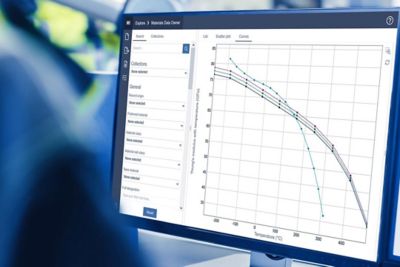
Use curated, accurate data from a materials database that contains information for all physics on the same material and grade.
Seamless Access to Material Properties Everywhere and for Everyone
Suppose that you have found the material you need in company files and are now ready to put temperature-dependent properties in a simulation. In the files, this comes in the form of a table in which the temperatures are on one side and the properties are on the other. The table has about 500 entries, so you spend an hour manually inputting this table into the simulation software. This is a time-consuming, error-prone process — a disaster waiting to happen — leading to repeat simulations because they will fail or show strange behavior if a property has been entered erroneously.
So what is the best solution to this?
The easiest option would be to pass the temperature-dependent data directly into the simulation software with one click, with no verification or manual input needed. This is exactly what the Granta MI platform and Ansys Granta Materials Data for Simulation (MDS) properties database offer. As a simulation engineer, you don’t even have to access the materials management database or the materials library to find the material properties you need. You can use the integrations in the Ansys solvers, as found in Ansys Mechanical structural finite element analysis software, Ansys Discovery 3D product simulation software, the Ansys Electronics Desktop (AEDT) electronics systems design platform, and more. The needed properties can be accessed directly with as little as one click.
You can massively boost your productivity without ever leaving your simulation environment.
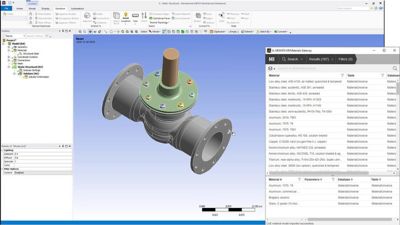
Seamlessly access materials information directly from your simulation environment.
Discover the Potential of an Open Ecosystem for Materials Information
Materials and materials information are enterprise-level issues.
To have the most accurate simulation possible, it is important to have the actual materials that are used in the design — the materials from which the product will be manufactured. For this reason, it is crucial to be able to connect the materials information management system to all the engineering tools that a company uses, from product life cycle management (PLM), computer-aided design (CAD), and simulation to computer-aided engineering (CAE), computer-aided manufacturing (CAM), and enterprise resource planning (ERP).
It is fundamental that the materials information management system can integrate seamlessly with all these tools and that it offers the flexibility that each organization requires. To this end, the Granta MI platform can integrate with all the major PLM, CAE, and ERP software systems to ensure that accurate data is passed along the design and engineering process, reducing the friction of manually inputting data and ensuring precision in multiphysics simulation. The platform provides a Python application interface (API) to allow users to tailor things to their own workflows and freely transfer data around the organization while still maintaining the single source of truth, with the master version stored centrally. And if your system is not supported off the shelf, a custom exporter can be developed and integrated with the platform.
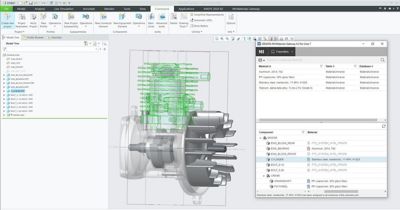
Connect computer-aided design (CAD), product life cycle management (PLM), and enterprise resource planning (ERP) systems with the Ansys Granta MI materials intelligence platform to ensure consistent materials information across the product life cycle.
Optimizing Shared Data Capabilities
Materials are the key to accurate, reliable, and trustworthy simulation. This is not just about the material properties themselves but about how we manage them, how we access them, how we share them, how we trace them, and how we ensure that they are accurate and consistent across different design and engineering departments.
The Granta MI platform offers a range of materials information management software designed for companies to realize their in-house materials intelligence. The platform offers a scalable solution to create, control, and store your company’s valuable material data, enabling seamless integration with leading CAD, CAE, and PLM systems for enterprisewide consistency. Make smarter material choices and choose the optimal material for your application with Ansys Granta Selector materials selection software. Trade off material properties using a comprehensive database to help you select the best-suited material for an application. Boost your simulation accuracy with access to the platform’s materials data libraries.
To learn how a materials management solution can benefit your team, request a free assessment today.
Want to know more about how materials can help boost multiphysics simulation accuracy? Register for the webinar “Ansys 2024 R2: Enhancing Simulation Accuracy With Materials Intelligence” to get more details on all the topics above.














